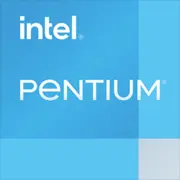Intel Pentium 967

Intel Pentium 967: A Moderate Classic for Basic Tasks in 2025
Introduction
The Intel Pentium 967 processor is a representative of the Sandy Bridge era, launched in 2011. Despite its age, in 2025, such chips are still found in entry-level budget laptops. This article will explore who might benefit from this processor today, how it handles tasks, and whether it is worth considering.
1. Architecture and Process Technology: The Foundation of Sandy Bridge
Cores, Threads, and Frequencies
- Cores and Threads: 2 physical cores, 2 threads (without Hyper-Threading).
- Frequencies: Base — 1.3 GHz, Turbo Boost — up to 1.3 GHz (turbo mode is effectively absent).
- Process Technology: 32 nm.
- Cache: 3 MB L3.
Integrated Graphics (iGPU)
- Model: Intel HD Graphics (Sandy Bridge).
- GPU Frequency: 350–1000 MHz.
- Capabilities: Supports DirectX 10.1, basic video output up to 1080p. Not suitable for gaming in 2025—can only handle HD video and simple 2D applications.
Architecture Features:
Sandy Bridge introduced improved IPC (instructions per clock) compared to previous generations, but by modern standards (e.g., compared to Intel Alder Lake or AMD Zen 4), it is a "dinosaur." The lack of AVX2 support and limited multi-threading capabilities are noteworthy.
2. Power Consumption and TDP: Savings at the Expense of Performance
- TDP: 17 W.
- Real-life Metrics: Under peak load — up to 20 W, in idle mode — less than 5 W.
- Cooling: Passive or miniature cooler. Laptops with this CPU are almost silent.
Practical Example: The Acer Aspire One laptop with the Pentium 967 does not require a robust cooling system—an aluminum heatsink is sufficient. However, under prolonged load (e.g., running 10 browser tabs), throttling may occur.
3. Performance: Bare Minimum for Survival
Real Task Tests
- Office Work:
— LibreOffice, Google Docs — run without lags but with delays when several documents are opened simultaneously.
— Zoom conference + browser — possible stuttering.
- Multimedia:
— YouTube 1080p/30 fps — plays, but starts stuttering at 60 fps.
— Photo editing in GIMP — only basic edits (cropping, filters).
- Gaming:
— Minecraft (Low settings) — 20-25 FPS.
— Stardew Valley — consistently 30 FPS.
— Modern games (2023+) — do not launch.
Turbo Mode: Effectively does not work—the frequency is fixed at 1.3 GHz. Any load immediately utilizes both cores at 100%.
Geekbench 6:
- Single-Core: 220.
- Multi-Core: 206.
For comparison: Apple M1 (2020) — 2300/7500, Intel Celeron N4500 (2023) — 450/800.
4. Usage Scenarios: Who is the Pentium 967 Suitable For?
- Suitable For:
— Users in need of a cheap laptop for text work, email, and YouTube.
— Educational devices for children (not for gaming).
— Backup laptops for travel.
- Not Suitable For:
— Gamers, designers, programmers.
— Those working with "heavy" applications (Photoshop, Blender).
Example: The Dell Inspiron 15 3000 laptop with the Pentium 967 (price in 2025 — $250) — a good option for retirees or humanities students.
5. Battery Life: Modest Appetite
- Working Time: 6-8 hours (with a battery capacity of 40 Wh).
- Power Saving Technologies:
— Intel SpeedStep: dynamic frequency adjustment.
— C-states: disabling unused cores.
Tip: To extend battery life, disable Wi-Fi and lower the screen brightness — this can provide an additional 1.5-2 hours.
6. Comparison with Competitors: Against Modern Chips
Analogues from 2011–2025:
- AMD E-450 (2011): Weaker in single-threaded tasks but better in graphics.
- Intel Celeron N4500 (2023): 2-3 times faster, TDP 6 W, laptop prices starting from $300.
- Apple M1 (2020): Performance 10 times higher but devices are more expensive ($600+).
Conclusion: The Pentium 967 in 2025 is an outsider. Its only advantage is the low price of devices based on it ($200–300 compared to $400–500 for models with the Celeron N4500).
7. Pros and Cons: Balancing Capabilities
Strengths:
- Extremely low cost of laptops.
- Sufficient performance for basic tasks.
- Cool and quiet operation.
Weaknesses:
- Struggles with multitasking.
- No support for modern standards (USB-C, Wi-Fi 6).
- Outdated graphics.
8. Recommendations for Laptop Selection
- Type of Device: Entry-level ultrabook (e.g., Lenovo IdeaPad Slim 1).
- What to Look For:
— RAM: Minimum 8 GB (4 GB in 2025 will be a struggle).
— Storage: Must have an SSD (even 128 GB is enough for Windows 11 Lite).
— Display: IPS matrix; otherwise, eyes will tire from TN.
— Ports: HDMI and USB 3.0 are essential—USB-C is rare.
Prices: New laptops with Pentium 967 cost $200–300 (e.g., HP 14s-fq0000). However, it's better to pay an additional $100–150 to get a model with Celeron N4500 or AMD Athlon Silver.
9. Final Verdict: Is It Worth Buying?
The Pentium 967 is suitable if:
- You need an extremely cheap laptop for text work and internet use.
- Battery life is more important than speed.
- A device is needed for "backup" usage.
Key Benefits:
- Price lower than mid-range smartphones.
- Reliability (the chip has been tested over the years).
Alternative: Used laptops from 2020–2023 (e.g., with Ryzen 3 3250U) for the same $200–300 will be more powerful, but without a warranty.
Conclusion
The Intel Pentium 967 in 2025 is a choice for those who prioritize savings over performance. It can handle basic tasks, but be prepared to make compromises. If your budget allows, it's better to consider modern budget processors—they will provide more future-proofing.
Basic
CPU Specifications
Memory Specifications
GPU Specifications
Miscellaneous
Benchmarks
Compared to Other CPU
Share in social media
Or Link To Us
<a href="https://cputronic.com/en/cpu/intel-pentium-967" target="_blank">Intel Pentium 967</a>